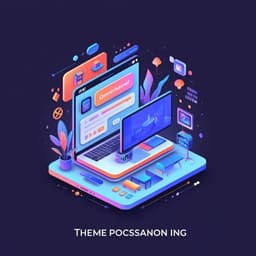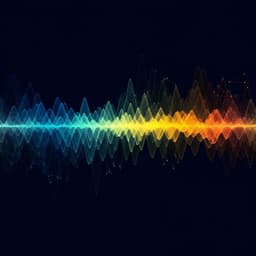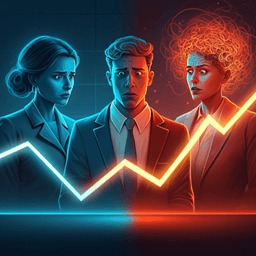
Linguistics and Languages
The impact of text type on Chinese-English translation effort: an investigation with reference to translation entropy
X. Liu and Y. Cui
This groundbreaking research by Xiao Liu and Ying Cui delves into how different types of source texts affect Chinese-English translation effort. Through innovative eye-tracking and key-logging experiments, the study reveals significant variations in translation effort, highlighting the complex relationship between text features and translation uncertainty.
~3 min • Beginner • English
Introduction
The study investigates how source text type impacts Chinese–English translation effort and explores why such impact occurs by referencing translation entropy, a measure of uncertainty in selecting target options. Translation involves comprehension of the source text and reformulation into the target text, with effort influenced by the number of viable translation options (uncertainty). Higher uncertainty implies more cognitive resources are needed to decide among alternatives. The authors hypothesize that different text types (legal, news, advertising, poetic), with distinct textual functions and linguistic features, exhibit different levels of translation entropy, which in turn correlate with differences in translation effort. The purpose is to integrate process-based (eye-tracking, key-logging, subjective ratings) and product-based (translation entropy) indicators to explain how and why text type affects translation effort, addressing gaps in prior work that focused mainly on correlations without accounting for the mechanism via translation uncertainty.
Literature Review
Text type and translation effort: Building on Reiss’s typology of textual functions (informative, expressive, operative), the paper notes that legal and news texts prioritize information, poetry prioritizes expression, and advertising emphasizes operative effects. Linguistic features differ across types (e.g., legal: jargon and complex syntax; news: concrete wording and simple syntax; poetry: rhetorical/aesthetic devices; advertising: concise, catchy wording and simple structures). Prior studies show text type affects effort, often finding legal texts more demanding than news or business letters, but coverage of text types has been limited and mostly process-focused, leaving mechanisms underexplored. Measurement of translation effort: Krings’s three dimensions (temporal, technical, cognitive) are widely used. Process-based indicators include subjective ratings; key-logging metrics (production time, keystrokes/edits, pauses); and eye-tracking metrics (fixation counts/duration). Product-based indicators: Translation entropy (from information theory) quantifies uncertainty in choosing TT options for a given ST item. Entropy relates to comprehension, transfer, and production uncertainty and is influenced by lexical, phrasal, and syntactic features. Prior empirical work shows positive correlations between entropy and effort (reading time, fixation, translation time, pauses), with higher entropy for polysemy, abstract words, figurative expressions, passive syntax, and syntactic variation. The paper posits that text type will modulate translation entropy and thereby effort.
Methodology
Design: Mixed-methods experimental study combining eye-tracking, key-logging, and post-task questionnaire, plus product analysis to compute translation entropy at phrasal and syntactic levels. Tools: Gazepoint GP3 HD Desktop Eye Tracker (150 Hz; 9-point calibration) with chinrest at 60 cm from a 1920×1080 monitor; Translog II (v2.0.1.222) for key-logging. Participants: 31 Chinese L1 postgraduate translation students (26 female, 5 male), aged 22–28 (M=22.63, SD=1.43), with ~1 year of translation study, touch-typing, right-handed, normal/corrected vision, no neurological/psychological impairments; informed consent obtained; small gift provided. Materials: Four Chinese source texts (~50 characters each) representing text types and functions—news (informative, concrete/simple), legal (informative, jargon/complex syntax), advertising (operative, concise/catchy), poetic (expressive, rhetorical devices). Pretest ratings (N=28 English majors) on 1–5 difficulty: news 1.61, legal 2.32, poetic 2.61, advertising 1.64 (all <3, indicating suitability). Procedure: Orientation and warm-up in Translog; external electronic dictionary available and used in warm-up to enhance ecological validity; eye-tracker calibration; participants translated the four texts in random order, no time limit but asked to work efficiently; post-task online questionnaire for subjective effort ratings (SR). Data processing: Eye-tracking data completeness verified. Fixations filtered with 100 ms lower threshold (typical reading fixation range 100–500 ms). Eye-movement indicators normalized by ST word count: fixation duration per ST word (FDw), fixation count per ST word (FCw). Key-logging: Pause threshold 300 ms; indicators normalized by ST word count: total translation time per ST word (TTw), total edits per ST word (TEw), pause duration per ST word (PDw), pause count per ST word (PCw). Entropy computation: Manual ST–TT alignment at phrasal and syntactic levels to count translation variants; probabilities p(s–tᵢ)=count(s–tᵢ)/#translations; entropy H(s)=Σ p(s–tᵢ)·(−log₂ p(s–tᵢ)). Statistical analysis: For effort indicators across text types, Friedman tests with Kendall’s W for effect sizes; Dunn’s post hoc pairwise comparisons. For entropy across text types, Kruskal–Wallis tests with n² effect sizes. Linear mixed-effects models (LMMs) tested relationships between entropy (fixed effect; phrasal or syntactic) and effort indicators (SR, TTw, TEw, FDw, FCw, PDw, PCw), with participants’ English proficiency as random effect; model selection via BIC; effect sizes via Cohen’s f; residual checks for normality.
Key Findings
• Significant differences in effort across text types on all indicators (Friedman): SR (p<0.001, W=0.52), TTw (p=0.01, W=0.12), TEw (p<0.001, W=0.20), FDw (p<0.001, W=0.20), FCw (p<0.001, W=0.21), PDw (p<0.001, W=0.14), PCw (p<0.001, W=0.15). Means by text (A=advertising, N=news, L=legal, P=poetic): SR A 2.97, N 2.68, L 4.00, P 3.55; TTw A 7.89, N 6.73, L 8.11, P 6.99; TEw A 9.37, N 7.48, L 7.64, P 7.60; FDw A 1.34, N 1.10, L 1.65, P 1.36; FCw A 5.45, N 4.49, L 6.78, P 5.17; PDw A 7.20, N 5.97, L 7.32, P 6.05; PCw A 3.51, N 3.28, L 4.11, P 3.47. • Pairwise comparisons (Dunn’s): Legal shows higher SR, FDw, FCw, PCw than advertising (p≤0.03); higher SR, TTw, FDw, FCw, PDw, PCw than news (p≤0.02); higher SR, TTw, FCw, PDw, PCw than poetry (p≤0.03). News generally lower than advertising and poetry; TEw significantly higher in advertising vs news (p<0.001); SR significantly higher in poetry vs news (p<0.001). Advertising vs poetry: SR lower for advertising (p=0.01), TEw higher (p<0.001), other indicators not significant. • Translation entropy differs significantly across text types: Phrasal entropy χ²=18.33, p<0.001, n²=0.54; Syntactic entropy χ²=9.80, p=0.02, n²=0.29. Ordering: Legal highest, then poetic, advertising, news. • LMMs show positive relationships between entropy and effort (except edits): Phrasal entropy positively predicts SR (β=0.59, p<0.001), TTw (β=0.56, p=0.01), FDw (β=0.26, p<0.001), FCw (β=1.06, p<0.001), PDw (β=0.49, p=0.03), PCw (β=0.25, p=0.02); not significant for TEw (β=0.41, p=0.11). Syntactic entropy similarly predicts SR (β=1.01, p<0.001), TTw (β=1.03, p=0.01), FDw (β=0.45, p<0.001), FCw (β=1.88, p<0.001), PDw (β=0.92, p=0.02), PCw (β=0.41, p=0.02); not significant for TEw (β=0.65, p=0.13). Random effect (English proficiency) negligible. • Overall ranking of effort and entropy aligns: Legal highest effort/entropy; news lowest; poetry generally higher than advertising on perceived difficulty and entropy. Findings support translation entropy as a reliable predictor of translation effort.
Discussion
The findings demonstrate that text type substantially affects temporal, technical, and cognitive effort due to distinct linguistic features and textual functions that impose different processing demands. Legal texts, with specialized jargon, complex syntactic structures, and system-specific terminology, elicit the highest fixation counts/durations, pauses, and time, indicating elevated cognitive and temporal load; this aligns with prior evidence that legal texts are more demanding than news or general business texts. News texts, characterized by concrete vocabulary and simple syntax, exhibit the lowest effort measures. Advertising vs news differences suggest that, despite simple forms, the operative function of advertising (persuasion, stylistic effects) increases transfer/production uncertainty and effort compared to the primarily informative news. Advertising vs poetry shows mixed results: subjective ratings indicate poetry is harder, consistent with higher entropy from figurative language; technical edits (TEw) are higher in advertising but do not necessarily reflect higher cognitive effort. Entropy analyses explain why text type impacts effort: different text types present different degrees of translation uncertainty at phrasal and syntactic levels, which positively correlates with process indicators (SR, time, fixations, pauses). The positive entropy–effort relationship holds for a distant language pair (Chinese–English), reinforcing entropy’s generalizability as a predictor. Practically, results imply the need for targeted training (e.g., legal domain knowledge) to mitigate uncertainty-driven effort, and for awareness of functional requirements in advertising and literary translation.
Conclusion
This study integrates process and product measures to show that source text type significantly impacts Chinese–English translation effort. Differences in linguistic features and textual functions yield different levels of translation uncertainty, captured by translation entropy, which in turn predicts effort. Both phrasal and syntactic entropy vary across text types, and entropy is positively correlated with subjective and behavioral effort indicators (except edits). Effort ranking mirrors entropy: legal > poetic > advertising > news. The research substantiates translation entropy as a reliable predictor of translation effort and provides a mechanistic account of how text type affects translators’ cognitive processes. Future research should involve professional translators and longer texts to enhance ecological validity and to further probe differences, particularly between advertising and poetic texts.
Limitations
Participants were student translators, which, while yielding a homogeneous sample, limits generalizability relative to professionals. The experimental materials were short passages (~50 characters) to prevent fatigue, which may have attenuated differences in linguistic features (e.g., between advertising and poetic texts).
Related Publications
Explore these studies to deepen your understanding of the subject.







